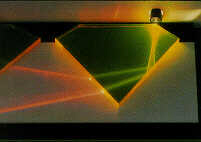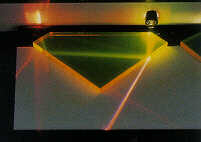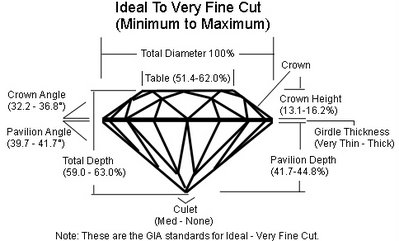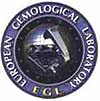Diamond Carat Weight
Carat weight is the weight of the diamond measured in carats. One carat is divided into 100 "points," so that a diamond of 75 points weighs 0.75 carats. Carat weight is the most obvious factor in determining the value of a diamond. But two diamonds of equal carat weights can have very different prices, depending on their quality. Diamonds of high quality can be found in all size ranges. Since diamonds are measured by carat weight, and not size, two diamonds of the same weight could have different sizes. Why? If a diamond is cut too shallow (or flat) it will have a larger diameter, but shallow depth and appear larger. Likewise, if a diamond is cut too deep (or pointed) it will have a smaller diameter and deep depth and appear smaller. This is why cut is so important. You want to make sure the diamond is cut to proper proportions. Not only does it make a large difference in the diamond's ability to reflect light, but a poorly cut diamond will not be proportionate in size to a diamond cut to proper specifications. For example, let's say you're interested in a 1.00ct diamond solitaire with a table of only 49%, the diamond will be cut way too steep and will look like a 0.80ct diamond instead.
Since diamonds are measured by carat weight, and not size, two diamonds of the same weight could have different sizes. Why? If a diamond is cut too shallow (or flat) it will have a larger diameter, but shallow depth and appear larger. Likewise, if a diamond is cut too deep (or pointed) it will have a smaller diameter and deep depth and appear smaller. This is why cut is so important. You want to make sure the diamond is cut to proper proportions. Not only does it make a large difference in the diamond's ability to reflect light, but a poorly cut diamond will not be proportionate in size to a diamond cut to proper specifications. For example, let's say you're interested in a 1.00ct diamond solitaire with a table of only 49%, the diamond will be cut way too steep and will look like a 0.80ct diamond instead.Diamond Clarity
Diamond Clarity is a measure of a diamond's internal flaws and impurities. A diamond that is virtually free of interior or exterior inclusions (commonly reffered to as flaws) is of the highest quality, for nothing interferes with the passage of light through the diamond. To determine a diamond's clarity, it is viewed under 10x magnification by a trained gemologist. Small inclusions neither mar its beauty nor endanger its durability.

Flawless - No internal or external flaws.
Internally Flawless - No internal flaws. Very rare and beautiful diamonds which are quite expensive.
VVS1, VVS2 - Very, Very Slightly Included: Very difficult to see inclusions under 10x magnification. An excellent quality diamond.
VS1, VS2 - Very Slightly Included: Inclusions are not visible to the unaided eye. Less expensive than the VVS1 or VVS2 grades.
SI1, SI2 - Slightly Included: Inclusions are visible under 10x magnification, SI clarity diamonds are usually of the best value since inclusions are not visible to the naked eye and prices are reasonable when compared to prices of the VS2 clarity and up grades.
SI3 - Slightly Included-EGL: SI3 is an EGL grade and is not recognized by GIA or other gemological institutions. It may be graded by GIA as either SI2 or I1. SI3 diamonds never have any black inclusions or cracks visible to the naked eye, but may have some very minor white inclusions which can be seen with the naked eye.
I1 - Included: an I1 clarity diamond will have a visible flaw which can be seen with the naked eye, but there should only be one major flaw which is not too obvious. If your budget only allows for an SI3 or I1 clarity diamond, be sure to examine it thouroughly before purchasing and make sure you can not see any inclusions.
I2, I3 - Included: These diamonds will have inclusions visible to the naked eye, and will have many black spots from the black inclusions and appear cloudy from the white inclusions, feathers and cracks.
Diamond Color
The diamond color grading scale varies from totally colorless to light yellow. The differences between one diamond color grade and another are very subtle and difficult to distinguish.
 D-F : Colorless: perfect or almost perfect color.
D-F : Colorless: perfect or almost perfect color.G-J : Near colorless: good to very good color, and this diamond may "face up" colorless when mounted, especially in white gold or platinum.
K-M : Light but noticeable yellow or brown tint. Not recommended for larger diamond stone purchases, especially in engagement rings.
Out of the 4 C's, color and cut are the two most important characteristics of a diamond. Do not compromise on color. An "H" color or better is usually best.
Diamond Cut
Many people confuse diamond cut with the shape of a diamond. Most diamonds are cut round with a full 58 facets, and a good cut, or make, has more scintillation, more sparkle. Although the cut of the diamond may affect the value of the diamond, the shape, is largely a matter of personal preference and does not affect the value significantly. It is the work of a master cutter that allows the diamond to be cut in such a way as to permit the maximum amount of light to be reflected through the diamond, and that's a great reflection on you. It is the cut that enables a diamond to make the best use of light. For more about the cut of our diamonds, please see the next section below.
1. When a diamond is cut to good proportions,
light is reflected from one facet to another and
then dispersed through the top of the stone.

2. If the cut of the diamond is too deep,
some light escapes through the opposite side of the pavilion.

3. If the cut is too shallow, light escapes through
the pavilion before it can be reflected.

Ideal Cut Diamonds
So what is Ideal Cut? Everyone has their own opinion on what Ideal is. Some people prefer a diamond to have a somewhat larger table, say around 60%, so the diamond "looks" bigger, some want the Tolkowsky Ideal cut, as calculated in the early 20th century by mathematician Markov Tolkowsky. The diagram below describes the Class 1 and 2 grades of GIA. They are the largest body in the world for diamond grading, and we use their classifications to grade our diamonds. Class 1 is Ideal. Class 2 is Very Fine, Class 3 is Fair, and Class 4 is Poor. We do not sell Class 3 or 4 diamonds. All diamonds we sell that are 0.50ct or larger on this website fall into the GIA's definition of "Ideal - Very Fine" Class, and are as follows:

Please keep in mind that diamonds other than round brilliant do not always have their cuts measured in such detail because they are classified as "fancy cut" diamonds and have very loose tolerances. For more information regarding our "fancy cut" diamond specifications, please contact us.
When buying a diamond, especially a round brilliant cut diamond, it is always best to have a complete analysis of cut. This will tell you all the specifications of the diamond's cut such as table percentage, depth percentage, etc., usually obtained from a scope (or megascope). Ask your jeweler for this report on cut if you are making a large diamond purchase.
Please visit our fancy shape diamond specifications page for other shapes besides round brilliant.
Diamond Grading and Gemological Reports
There are a variety of Gemological Institutes that appraise diamonds and issue Diamond Gemological Reports, measure and certify loose diamonds and diamond jewelry. Depending on your region, there are a number of reputable companies including the following listed below.
 HRD - Hoge Raad Voor Diamant (The Diamond High Council). The officially recognised representative of the Belgium diamond trade and industry. HRD headquarters are located in Antwerp, World Diamond Center.
HRD - Hoge Raad Voor Diamant (The Diamond High Council). The officially recognised representative of the Belgium diamond trade and industry. HRD headquarters are located in Antwerp, World Diamond Center.
IGI - International Gemmological Institute. The oldest institute of its kind in Antwerp. Set up in 1975 with labs in New York, Bangkok, Mumbai and Tokyo
 GemScan - GemScan International was incorporated in 1985 as an independent jewellery appraisal laboratory providing gem identification. Gemscan is based in Toronto, Ontario Canada.
GemScan - GemScan International was incorporated in 1985 as an independent jewellery appraisal laboratory providing gem identification. Gemscan is based in Toronto, Ontario Canada.
EGL - European Gemological Laboratory. EGL was originally opened in Antwerp in 1974, and now has
laboratories in Antwerp, New York Los Angeles, Johannesburg, Paris, London, Israel and Seoul

GIA - Gemological Institute of America. Founded in 1931 in Los Angeles, the GIA created and introduced the international grading system. Headquarters are still located in Los Angeles.

AGS - American Gem Society Founded in 1934 by Robert M. Shipley who also founded the GIA. The AGS is based in Nevada, USA.

Marquise - Like the emerald, the marquise is a traditional shape. This is probably the fourth most popular shape behind the round, princess and oval.
 Heart - Hard to find due to low demand, but some people prefer a heart shape diamond for sentimental purposes.
Heart - Hard to find due to low demand, but some people prefer a heart shape diamond for sentimental purposes.
Emerald - A more traditional shape, the emerald is not as popular as it used as it once was, but has an old world elegance to it.
 Princess - A square cut diamond that has refractive properties almost near round brilliant. The princess is the preferred square cut shape over radiant.
Princess - A square cut diamond that has refractive properties almost near round brilliant. The princess is the preferred square cut shape over radiant. Radiant - Popular before the princess shape was around, the radiant has more facets than a princess, but has the corners trimmed like the emerald shape. This shape is not widely popular.
Radiant - Popular before the princess shape was around, the radiant has more facets than a princess, but has the corners trimmed like the emerald shape. This shape is not widely popular.
Pear - Mostly used in pendants, the pear shape diamond is shaped in a tear drop shape and has fairly good proportions to refract light well.

Oval - Not as popular for solitaires, but very popular for three stone anniversary rings, with two matching diamonds on the sides.
 Round Brilliant - Do not confuse with round. The round brilliant is the modern version of the round which has been refined for maximum shine. The round brilliant is by far the most popular and has the best angles for which to shine maximum brilliance.
Round Brilliant - Do not confuse with round. The round brilliant is the modern version of the round which has been refined for maximum shine. The round brilliant is by far the most popular and has the best angles for which to shine maximum brilliance.
Subscribe to:
Post Comments
(
Atom
)



No comments :
Post a Comment